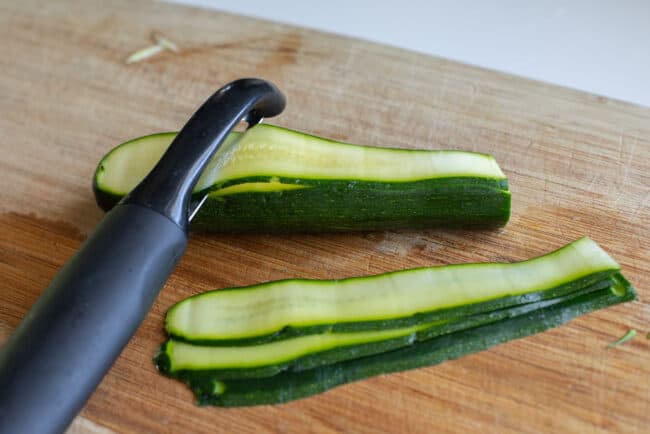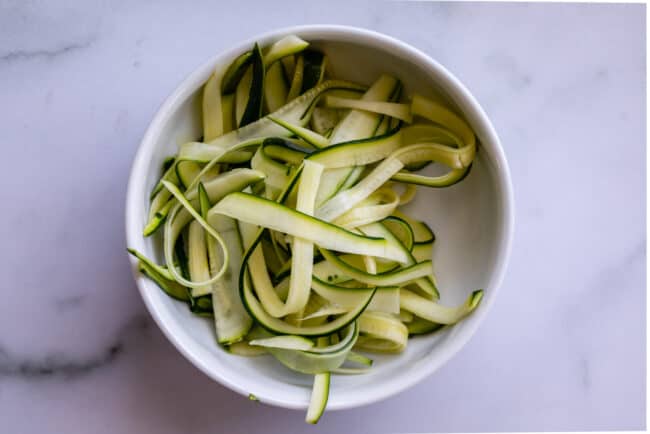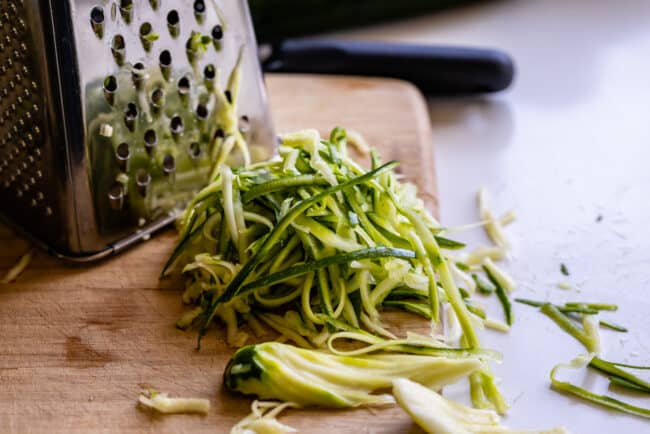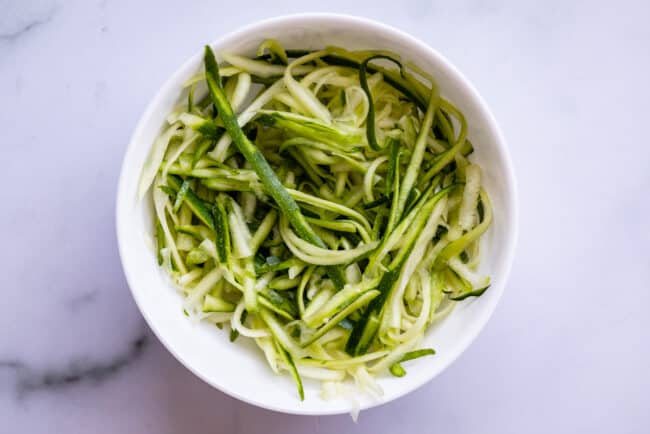Zoodles, or zucchini noodles, are a delicious low-carb gluten-free substitute for regular pasta. We’ll be walking you through the steps to make zoodles and various ways to eat them.
Zoodles is a word that combines both zucchini and noodles. Zoodles are created by thinly slicing a zucchini into noodles. After being cooked, the zoodles can be used in place of pasta. They are a fantastic alternative to carb-rich foods if you prefer low-carb meals, have gluten allergies, or are following a ketogenic diet.
How do you make zucchini noodles with a potato peeler?
And speaking of potato peelers, you can use one to make zoodles if you don’t have anything else. Peel the zucchini into ribbons, using as much force as possible for a thick zoodle. Then layer the ribbons on top of each other and slice into long thin strips with a knife. This is not my favorite method because I like thick zoodles, and these ones are going to turn out pretty thin, resulting in more watery zoodles if you are not careful.


You can also use a julienne peeler, if you have one. Although I imagine the zoodles would be pretty thin.
Finally, a box grater can be used to create zoodles as a last resort. Grate it lengthwise, making sure the strands are as long as you can. These “noodles” will be incredibly thin and will absorb a lot of water. Before sautéing, I would try to squeeze some of the water out in a paper towel. Not my preferred method because grated zoodles are almost never al dente.


With a Spiralizer
The Paderno World Cuisine Spiralizer is far and away my favorite tool. It creates curls of your favorite vegetables, literally in seconds. It’s the fastest tool of the bunch and requires the least amount of strength or effort (with suction cup feet to keep it in place). You simply cut off the ends of a zucchini, place it next to the blade and spin. In less than 8 seconds you’ll have spiral sliced the entire zucchini.
Although these reviews are for zucchini noodles, keep in mind that you might want to slice up other vegetables as well. Carrots, sweet potato, apples, pears…the list is endless!.
With the simple to change blades on this spiralizer, you can make your favorite carrot pasta, curly sweet potato fries, or apple chips. Although it is larger than some of the other options, I still prefer it over them all because of how frequently I use it.
PROS: requires little strength or effort, works quickly, is durable, affordable, and offers a variety of blades for slicing.
CONS: will require more storage space than other options.
The great thing about a julienne peeler is that you likely already have one in your kitchen. Win! A julienne peeler frequently does double duty with a vegetable peeler. One side juliennes, the other side slices. And that’s perfect for when you want thick, flat slices of zucchini pasta. The single biggest benefit of a julienne peeler is that it’s small. It takes up virtually no space in your kitchen and will most likely reside in your utensil drawer.
Using a julienne peeler, you can create the thinnest, most delicate zucchini noodles. Then, you simply pull the strands apart with your fingers. This tool comes in at number two on my list because it requires more time to use (you rotate the zucchini to create a rectangular shape), leaves the largest core, and presents a high risk of finger nicking (yep, I’m clumsy).
PROS: cheap and easy to store.
CONS: requires more time to cut and results in a fairly large core.
I actually hummed and hawed about making the mandoline #2 on my list (because I love it that much) – but the julienne peeler won for size. I’ve had this mandoline for several years and it gets used a ton in my kitchen.
The mandoline creates julienne noodles that are slightly thicker than a peeler, but does it in half the time. The blades are SUPER sharp on a mandoline, so please please always use the plastic holder or a cut-resistant glove. I’ve sliced a massive divot out of my thumb before – and it’s not fun.
The best flat zucchini pasta can be made with a mandoline, and you can adjust the thickness. It has several blade options, similar to the Paderno World Cuisine Spiralizer, giving you the choice of perfectly consistent noodles, slices, or rounds (and easily cutting through any “harder to slice” vegetable). Alright, maybe this is actually a tie for #2.
PROS: Slicing is quick and simple thanks to the sharp blade, and the output is always the same size.
CONS: Sharp blade (use caution when handling your fingers) and medium storage size
If you own a KitchenAid stand mixer, you are probably familiar with the wide range of attachments available. Although expensive, these attachments can be automated by connecting to the power hub on the mixer’s front. The KitchenAid does, in fact, have a spiralizer attachment.
The Kitchenaid spiralizer comes in a nice storage box (though it’s quite large) and provides the most blade options, with 7 blades (including a peeler). But even with all these blade options I found that I still gravitated toward the 3 basic blades – the same ones which are included with the Paderno Spiralizer.
Another thing to remember is that this automated tool has a fixed width. This necessitates cutting large zucchini in half, then spiralizing each half separately.
This is a great option if you already own a KitchenAid and enjoy using attachments. The cost alone, however, will likely be the biggest deterrent for everyone else.
PROS: only automatic spiralizer, comes with a peeler, and has the most blade options.
CONS: Fixed width, takes up the most storage space, and I discovered that using the Paderno Spiralizer by hand still allowed me to spiralize a zucchini more quickly.
The handheld spiralizer is the newest kid on the block and the solution for curly noodles in a small contraption. It produces zucchini noodles most similar to the Paderno Spiralizer, though they tend to be flatter and not as consistently sized. I was really hoping to love this little device, but with all the other options on the market, I had to rank it last.
When spiralizing several zucchini, it can be difficult to maintain straight zucchini slices and your wrist may hurt from all the twisting. Additionally, this tool will be the most challenging if you intend to spiralize other vegetables (such as carrots and sweet potatoes), as it demands the most strength and effort. Yes, it’s inexpensive, but occasionally you get what you pay for.
PROS: cheap and takes up little space.
Cons include inconsistent noodles, the need for strength and wrist power, and a lack of the other options’ versatility.
Tips on Making The Perfect Zoodles
FAQ
Can you use a mandoline to make zucchini noodles?
To complete the task, you can use a mandoline, a potato peeler, a small, inexpensive handheld spiralizer, or even a box grater.
